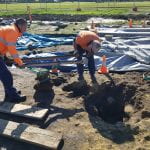I get to make a news announcement! How exciting. We’ve just put out a special edition journal for our Landscapes project. Below is the press release. If you cannot be bothered reading it, then the TLDR version is: we’re clever, we assembled a team of equally-clever people, they wrote eight clever articles on convict period history and archaeology of Port Arthur and the Tasman Peninsula. If you want to be clever you can get yourself a copy here. Click on the ‘Subscribe to the journal’ link at the top right (don’t worry, you’re not subscribing), fill in your dets and in ‘Volume’ select ‘Vol. 22, 2020’. Voila – knowledge will wing its way to you. If you have library access, you can also get yourself a digital copy through their repository.
The University of New England is pleased to release Volume 22 of its Journal of Australian Colonial History, a special volume on convict life and labour at Port Arthur Tasmania in the mid-nineteenth century. Edited by David Andrew Roberts and UNE Postdoctoral Fellow, Richard Tuffin, the volume flows out of the ARC funded Discovery Project, ‘Landscapes of Production and Punishment’, and features some of the best student research undertaken under the aegis of that project.
The Landscapes project brought together a team of historians, archaeologists and criminologists from the Universities of New England, Tasmania, and Liverpool, with industry partners at the Port Arthur Historic Site Management Authority, to devise new questions and methods for interpreting the Tasmania’s ‘Penal Peninsula’.
From the early 1830s Port Arthur received prisoners convicted of serious crimes in the Supreme Court, and others who ran afoul of employers and magistrates for lesser disciplinary offences. Today the remnants of the convict-built settlement comprise one of Australia’s most intact and evocative convict sites, now included on the UNESCO World Heritage List.
A particular aim of this research was to construe the local convict system as an industrial system, consisting of techniques for ensuring labour compliance and maximising output. Labour lay at the heart of nineteenth-century ideologies and practices of punishment and reform, reflected in colonial Australia through the locations and conditions under which convicts were set to work. From this labour came products and produce that not only sustained the convict system itself but played into larger trajectories of settlement and colonisation.
The work produced by the project team, and especially by its many undergraduate and higher degree research students, set new benchmarks for interrogating the archaeological and documentary evidence of convict industry in local settings, including the merging of data extracted from previously-unused industrial and production records with spatial data obtained through Light Detection and Ranging (LiDAR) scanning of landscape.
The best of the research is captured in eight articles in this volume of the JACH, covering topics including the application of skilled labour at Port Arthur, juvenile labour at Point Puer, the special treatment of ‘lunatics and invalids’ and trade-specific studies of brickmaking, woodworking and blacksmithing. In their notable contribution, Richard Tuffin, Hamish Maxwell-Stewart and Michael Quinlan demonstrate their ground-breaking method for analysing punishment data to reveal patterns of collective action amongst convicts at Port Arthur and the nearby Coal Mines.
The Journal of Australian Colonial History is the flagship publication of UNE’s Department of Archaeology., Classics and History, published continually since 1999. <www.une.edu.au/jach>



